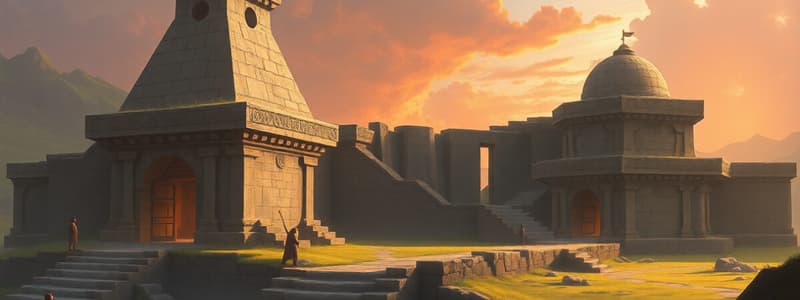Podcast
Questions and Answers
What is a defining characteristic of prehistoric architecture?
What is a defining characteristic of prehistoric architecture?
- Complex urban planning and design
- Incorporation of intricate architectural styles
- Use of advanced materials like steel
- Construction techniques primarily using earth and stone (correct)
Which ancient civilization is known for its monumental architecture like pyramids?
Which ancient civilization is known for its monumental architecture like pyramids?
- Greek
- Egyptian (correct)
- Harappan
- Mesopotamian
Which statement best describes Ancient Greek architecture?
Which statement best describes Ancient Greek architecture?
- It emphasized grandeur and monumental scale. (correct)
- It featured elaborate and ornate designs with no focus on symmetry.
- It utilized primarily wood and mud for construction.
- It was primarily functional with little aesthetic appeal.
What is a common theme across various prehistoric architectural structures?
What is a common theme across various prehistoric architectural structures?
Which of the following features is NOT associated with ancient architecture?
Which of the following features is NOT associated with ancient architecture?
Flashcards are hidden until you start studying
Study Notes
Prehistoric and Ancient Architecture
- The text explores the development of architecture from prehistoric times to ancient civilizations.
- It likely covers key milestones like the emergence of monumental structures, different building materials and techniques, and the evolution of architectural styles.
- The prehistoric architecture section could discuss early shelters, megalithic structures, and pyramid-like constructions.
- It might explore the use of natural materials like wood, stone, and earth in building.
- The ancient architecture section could delve into civilizations like Ancient Egypt, Greece, Rome, and others.
- Different architectural styles, including Egyptian pyramids, Greek temples, Roman aqueducts, and monumental tombs, would likely be discussed.
- The text probably analyzes the social, religious, and political contexts that shaped architectural development in these periods.
Egyptian Capitals
- This section likely focuses on the capital cities of ancient Egypt and their architectural significance.
- The text may discuss cities like Memphis, Thebes, and Alexandria.
- The key architectural features of these cities, including temples, palaces, tombs, and monumental structures, would be explored.
- It would probably highlight the role of architecture in showcasing power, religious beliefs, and social status in ancient Egypt.
Studying That Suits You
Use AI to generate personalized quizzes and flashcards to suit your learning preferences.




